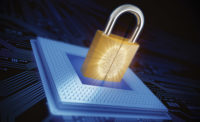FIELD GUIDE TO ACCESS CONTROL: Facts & Fiction: Working with Doors
Out of necessity, it is common for installers of electronic access control systems to make modifications to doors and frames. They are the last on the scene – long after the doors, frames, walls, floors and ceilings have been set in place. Then out come the drills, hole saws and chisels – and the modifications begin.
The door should be the first consideration, because it is the building component being controlled by the system and must balance both life safety and security.
In a Facts & Fiction format, this section of SDM’s Technicians’ Field Guide addresses some things to keep in mind when working with doors in an access control system installation.
FACT!
Installers are permitted to drill holes in fire-rated doors. This practice is acceptable as long as the hole does not exceed a diameter of one inch (except for cylinder holes), in accordance with NFPA 80 1-3.4. Note that the modifications may be done only to install approved fire labeled hardware. All mounting screws or bolts must be made of steel (NFPA 80 2-5.4) and any unused holes must be filled with steel bolts or screws or approved fire-resistant material (NFPA 80 15-2.5.4).
FICTION!
We have all received calls from customers saying, “I presented my card but the door won’t unlock,” only to discover that the user has pulled on the door, binding the electric strike and preventing it from releasing. This human-nature tendency can be overcome by installing electric strikes with a pre-load feature.
Pre-load is defined as the force that is applied to an electromechanical locking device that may bind or restrict its ability to release or unlock. Electric motors or solenoids are the most common technologies used to retract a latch bolt in a lockset or to release a keeper in an electric strike. It is difficult for these devices to overcome even small amounts of pressure that may inhibit the movement of the latchbolt or keeper. Pre-load could be caused by door and frame misalignment, heavy sound seal or weather-stripping, or it can be caused by someone pulling on the door before the electric strike is energized.
However, there are electric strikes and other electromechanical locking devices available to compensate for pre-load conditions up to 30 lb. This is achieved by incorporating the use of cams and/or clutching mechanisms within the locking device to create enough leverage to overcome the load. These features may add cost to the initial installation, but could later reduce maintenance cost and service calls.

FICTION!
In order to install an electric strike on a fire-rated opening, installers regularly remove drywall extending into the door frame to accommodate the body of the electric strike.
This is one of the most common code violations found with modified frames. According to NFPA 80, the drywall must penetrate (extend into) the frame a minimum of one-half inch. Removing the material to accommodate the electric strike destroys the degree of protection provided by the fire wall and door in the event of a fire.
The solution is to use a fire-rated strike that fits the opening without the necessity of removing the drywall. A fire labeled electrified exit device also could solve the problem.
The door should be the first consideration, because it is the building component being controlled by the system and must balance both life safety and security.
In a Facts & Fiction format, this section of SDM’s Technicians’ Field Guide addresses some things to keep in mind when working with doors in an access control system installation.
FACT!
You Can Modify a Fire Labeled Door
Installers are permitted to drill holes in fire-rated doors. This practice is acceptable as long as the hole does not exceed a diameter of one inch (except for cylinder holes), in accordance with NFPA 80 1-3.4. Note that the modifications may be done only to install approved fire labeled hardware. All mounting screws or bolts must be made of steel (NFPA 80 2-5.4) and any unused holes must be filled with steel bolts or screws or approved fire-resistant material (NFPA 80 15-2.5.4).FICTION!
Placing a Sign Reading ‘Don’t Pull until You Have Swiped Your Card’ Is the Best Way of Preventing Door Binding
We have all received calls from customers saying, “I presented my card but the door won’t unlock,” only to discover that the user has pulled on the door, binding the electric strike and preventing it from releasing. This human-nature tendency can be overcome by installing electric strikes with a pre-load feature.Pre-load is defined as the force that is applied to an electromechanical locking device that may bind or restrict its ability to release or unlock. Electric motors or solenoids are the most common technologies used to retract a latch bolt in a lockset or to release a keeper in an electric strike. It is difficult for these devices to overcome even small amounts of pressure that may inhibit the movement of the latchbolt or keeper. Pre-load could be caused by door and frame misalignment, heavy sound seal or weather-stripping, or it can be caused by someone pulling on the door before the electric strike is energized.
However, there are electric strikes and other electromechanical locking devices available to compensate for pre-load conditions up to 30 lb. This is achieved by incorporating the use of cams and/or clutching mechanisms within the locking device to create enough leverage to overcome the load. These features may add cost to the initial installation, but could later reduce maintenance cost and service calls.

FICTION!
Drywall Can Be Removed to Fit Electric Strike
In order to install an electric strike on a fire-rated opening, installers regularly remove drywall extending into the door frame to accommodate the body of the electric strike.This is one of the most common code violations found with modified frames. According to NFPA 80, the drywall must penetrate (extend into) the frame a minimum of one-half inch. Removing the material to accommodate the electric strike destroys the degree of protection provided by the fire wall and door in the event of a fire.
The solution is to use a fire-rated strike that fits the opening without the necessity of removing the drywall. A fire labeled electrified exit device also could solve the problem.
Looking for a reprint of this article?
From high-res PDFs to custom plaques, order your copy today!





